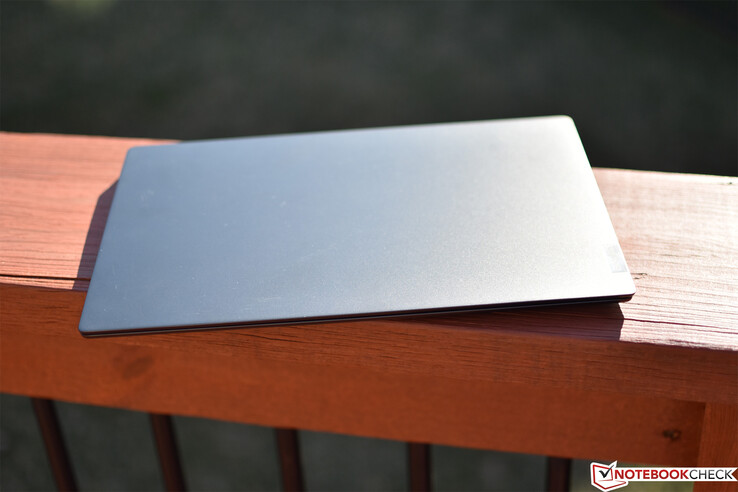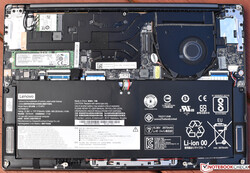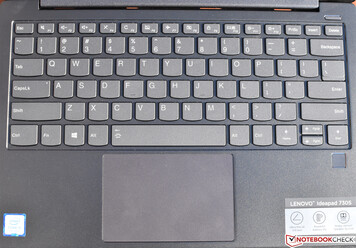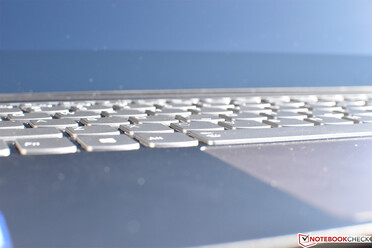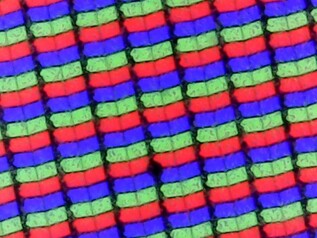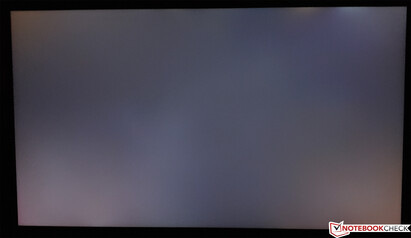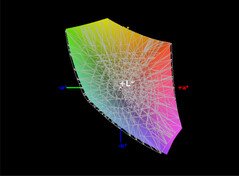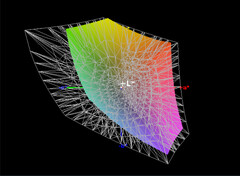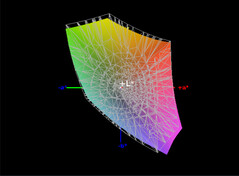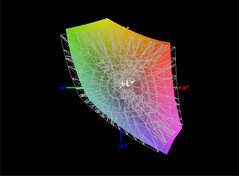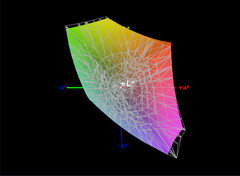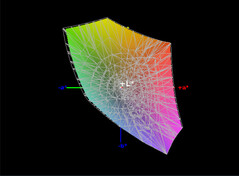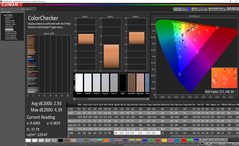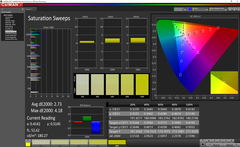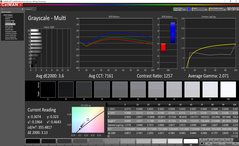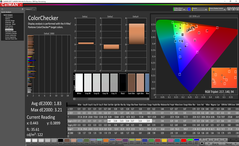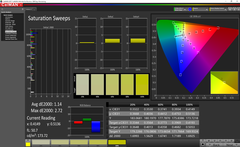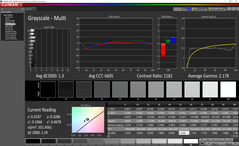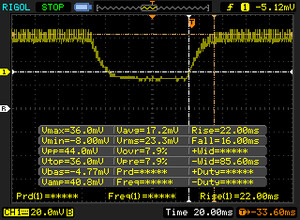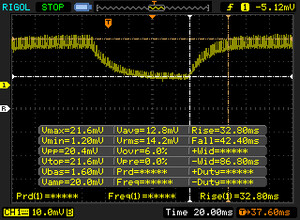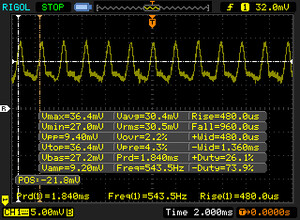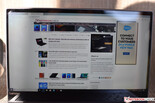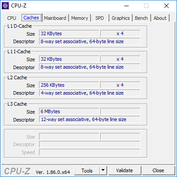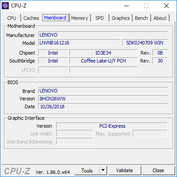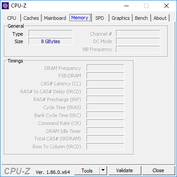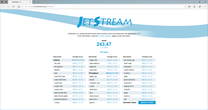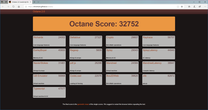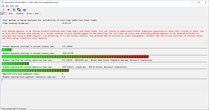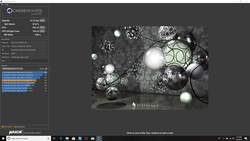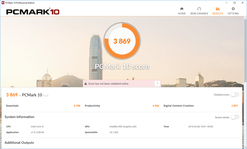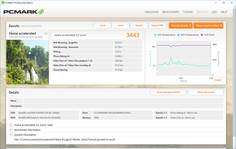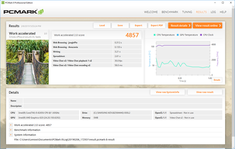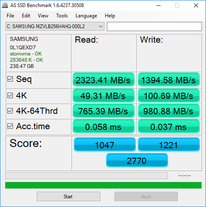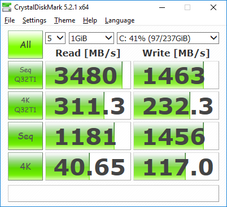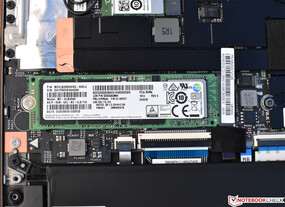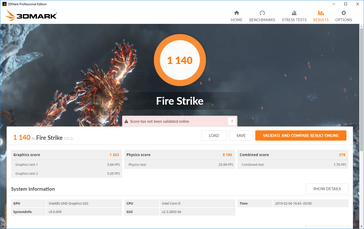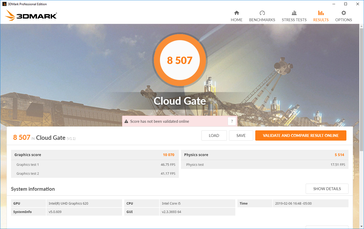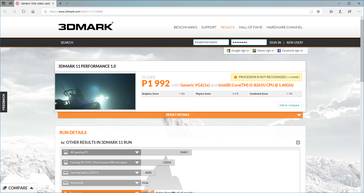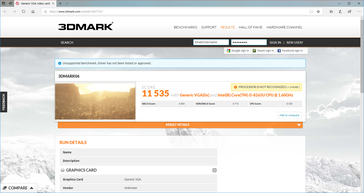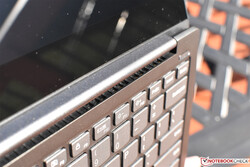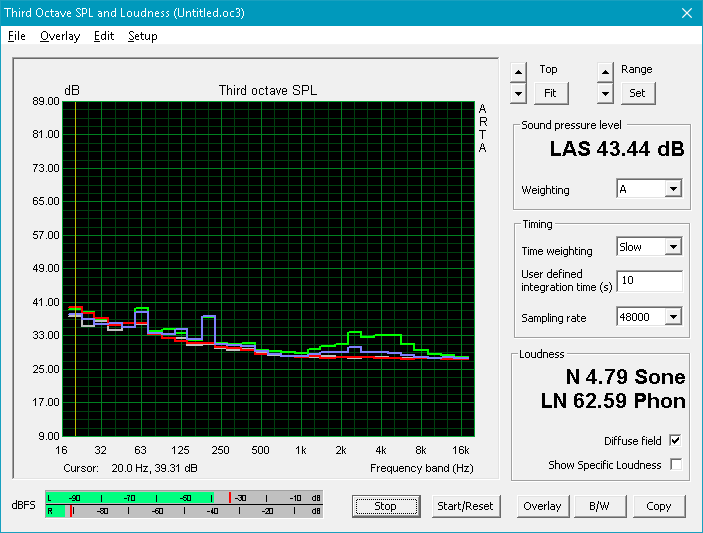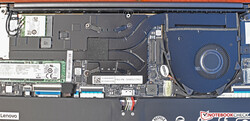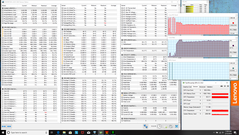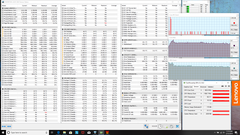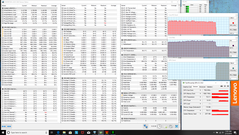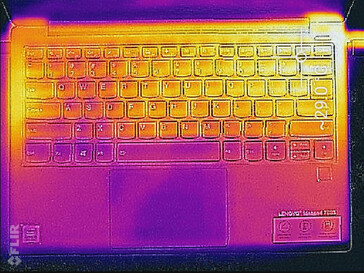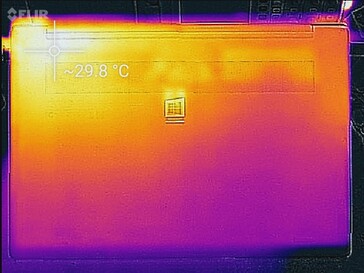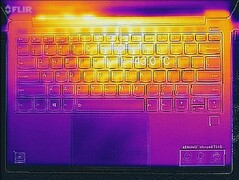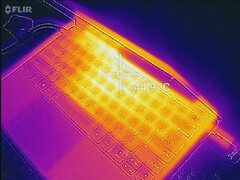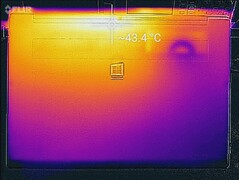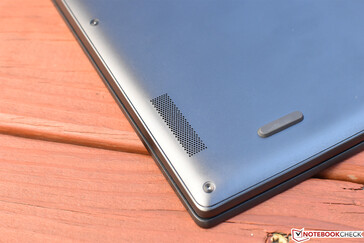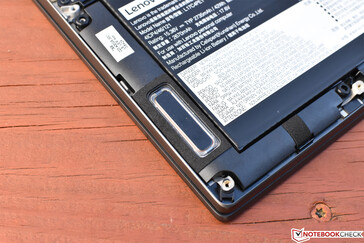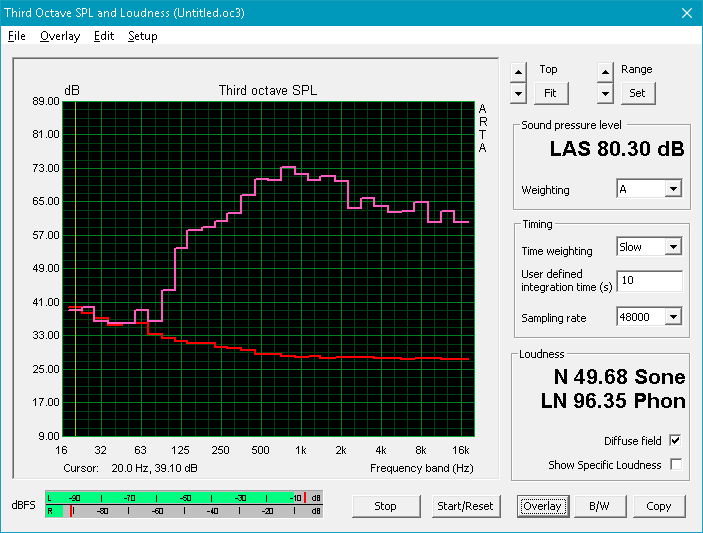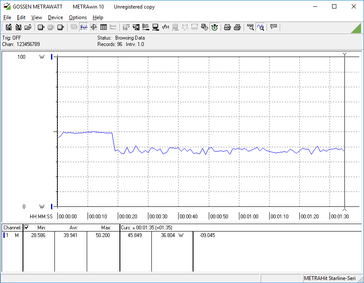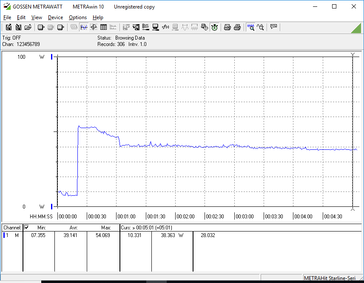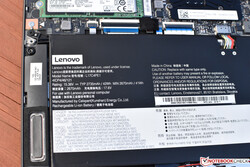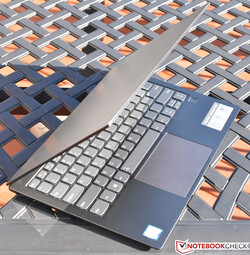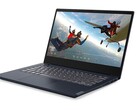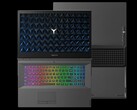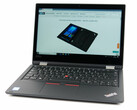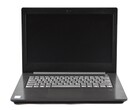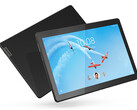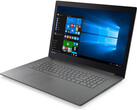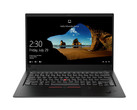Lenovo IdeaPad 730S-13IWL (i5-8265U, FHD) Laptop Review

With each passing year, ultraportables slim down even more to sizes hardly fathomable by the standards of the previous generation. In direct competition with other category leaders (such as the XPS 13 and Spectre 13) is Lenovo’s IdeaPad 730S, whose predecessor (the 720S) didn’t really trailblaze any new territory, but which proved capable enough to stand alongside these other behemoths of subnotebook fame.
Seeing as it shares many of the same internal components, the 730S is really more of a design upgrade than a refresh. Our review unit maintains the capable quad-core Core i5-8265U CPU, 8 GB LPDDR3 RAM, 256 GB NVMe SSD, and 1080p display, but it slims down the package to a mere 11.9 mm thickness and a (very slightly) smaller footprint to boot. Some of the materials have seen an upgrade as well, with the plastic bezel being replaced by metal and the new touchpad being made of glass. Perhaps the best news of all, however, is the price: at just $870, our review unit is relatively affordable in light of its specifications. Next, we’ll see how well it stands up to the scrutiny of our review process.
Case
Again, the biggest change the IdeaPad 730S has seen since the previous-generation IdeaPad 720S has been to the case design. While still purely aluminum in construction, the new case, weighing in at just 1.094 kg, is some 14% thinner at 11.9 mm (down from 13.6 mm previously) and swaps out the plastic display frame for edge-to-edge glass. Build quality is overall very good, with even gaps between surfaces and beautifully-machined edges. The bezel surrounding the screen measures just 6 mm on the sides and 10 mm on the top.
While the metal construction is a priceless asset, and the base unit is comfortably stable on a surface and under pressure, the display lid admittedly seems a bit perilously prone to torsion. One reassuring data point, however, is the fact that no screen artifacts are produced when pressure from behind is applied. Also, from a purely haptic standpoint, the feel of the metal is comfortable and high-quality all at once. Those bothered by fingerprints and skin oils will be happy to know that, unlike Dell’s Latitude lineup and some ThinkPad models, the IdeaPad 730S doesn’t collect much visually conspicuous gunk.
While this isn’t a convertible machine, the display lid opens all the way to 180 degrees (in fact, a bit beyond technically). Even in spite of the drop-hinge design, the large rear rubber foot lifts the machine sufficiently far off the surface that the lid clears it at extreme angles. Speaking of hinges, the single center hinge steadies the display well during use; only minor vibrations are present while typing or in transit. Regardless, it’s even possible still to open the display one-handed, which is a testament to the expertly-tuned hinge tension.
It’s honestly hard to imagine how Lenovo could shrink this machine much further without serious implications for its durability. As it stands, the IdeaPad 730S is one of the most portable machines in its class.
Connectivity
One of the negative side effects of such an extremely thin machine is a necessarily limited selection of ports. Standard Type-A USB ports and the typical HDMI/Ethernet ports wouldn’t even fit into this case, and as such, Lenovo was forced to go all in on USB Type-C/Thunderbolt connectivity with the 730S.
The only ports we get are the USB Type-C Gen 1/combined charging port, two Thunderbolt 3.0 ports, and a combo audio jack. Tragically absent are microSD and any sort of dedicated video output, though Thunderbolt is undeniably versatile in this application with the help of an adapter or docking station.
Communication
Wireless network connectivity is powered by a dual-band Realtek 8822BE 802.11ac PCIe adapter, which incorporates a 2x2 antenna design with MU-MIMO and is capable of data rates of up to 867 Mbps. This adapter also includes Bluetooth 4.1 connectivity.
In our tests, the adapter actually performs quite admirably, beating the ever-popular Intel Dual-Band Wireless-AC 8265 and nearly matching the Intel Wireless-AC 9560 in receive speeds. It similarly tops the charts in transmit capability as well.
The webcam is located above the top of the display (in the usual spot).
Accessories
In addition to an attractive packaging design, the 730S includes no accessories apart from its 65W USB Type-C AC adapter. The laptop can be charged using any of the three USB Type-C ports, which is always a convenient perk.
Maintenance
While limited, maintenance and upgrade procedures for the IdeaPad 730S are at least simple, with nine T5 Torx screws securing the bottom panel to the machine. The panel lifts off with minimal effort following the removal of the screws.
Inside, only the M.2 SSD, WLAN adapter, and battery are easily replaceable. The memory is soldered to the board and most other components require significant (near complete) disassembly to access.
Warranty
The IdeaPad 730S ships with a one-year depot warranty standard. Typical warranty upgrades such as longer terms and on-site service are, as always, available at the time of purchase. Please see our Guarantees, Return policies and Warranties article for country-specific information.
Input Devices
Keyboard
Lenovo’s reputation as king of the keyboards is mostly reinforced with the 730S. The chiclet keyboard features surprisingly good key travel for a laptop this thin—though it’s still on the short side overall—and just enough feedback for a reliable typing experience. Actuation force is medium and the crisp stop is quiet yet palpable. Key sizing is mostly conventional apart form the half-height Up/Down arrow keys (which also double, in conjunction with a Fn press, as the PgUp/PgDn keys). The one problem we have with our review unit is surely unique to our particular machine: the right Shift key is slightly crooked, leading to a bit of a sticky sensation when pressing it.
Like other Lenovo laptops, the keyboard is backlit and incorporates two brightness levels. The backlighting is even across the breadth of the keys. Visibility in bright environments is average; the reflective grey surface of the keys can mask the labels at particular angles, especially when working outdoors.
Touchpad
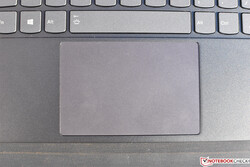
The glass clickpad is oversized at 104 mm x 69 mm. While many continue to lament the precision of such designs, the integrated buttons are about as good as they come, with no collateral pointer movement during actuation and precisely-interpreted clicks. The surface of the pad is smooth and conducive to effortless finger glides; the cursor moves slowly even during slow glides. Gestures are interpreted quickly and accurately by the Precision drivers, and there is little to no detectable lag between finger and pointer movement.
Display
At first glance, while the specifications haven’t changed, the 730S seems to have improved upon the display of its 720S predecessor as well. The glossy (edge-to-edge glass) FHD 1920x1080 screen is subjectively bright and relatively vivid to boot, with fairly deep blacks and an aesthetically-pleasing small bezel surrounding it. It’s a shame that no matte options exist, however, because without touch there is little practical reason to opt for a glossy finish.
In terms of backlight bleed, although the image below makes it look significant, in reality, the only truly noticeable spot is in the top right. The panel exhibits smooth color with no graininess.
| |||||||||||||||||||||||||
Brightness Distribution: 83 %
Center on Battery: 355.1 cd/m²
Contrast: 1110:1 (Black: 0.32 cd/m²)
ΔE ColorChecker Calman: 2.93 | ∀{0.5-29.43 Ø4.78}
calibrated: 1.83
ΔE Greyscale Calman: 3.6 | ∀{0.09-98 Ø5}
95% sRGB (Argyll 1.6.3 3D)
61% AdobeRGB 1998 (Argyll 1.6.3 3D)
66.7% AdobeRGB 1998 (Argyll 3D)
95.5% sRGB (Argyll 3D)
65.6% Display P3 (Argyll 3D)
Gamma: 2.071
CCT: 7161 K
| Lenovo IdeaPad 730S-13IWL 81JB0004US B133HAN05.1, IPS, 13.3", 1920x1080 | Dell XPS 13 9380 2019 ID: AUO 282B B133ZAN Dell: 90NTH, IPS, 13.3", 3840x2160 | HP Spectre Folio 13t-ak000 AU Optronics AUO572D, IPS, 13.3", 1920x1080 | Apple MacBook Air 2018 APPA039, IPS, 13.3", 2560x1600 | Microsoft Surface Laptop 2-LQN-00004 VVX14T092N00, IPS, 13.5", 2256x1504 | Lenovo Ideapad 720S-13IKB LG Philips LGD04EF, IPS, 13.3", 1920x1080 | |
|---|---|---|---|---|---|---|
| Display | -2% | 2% | 3% | 2% | -9% | |
| Display P3 Coverage (%) | 65.6 | 64.7 -1% | 66.2 1% | 67.8 3% | 68 4% | 64.3 -2% |
| sRGB Coverage (%) | 95.5 | 93.1 -3% | 97.4 2% | 96.1 1% | 94.7 -1% | 82.3 -14% |
| AdobeRGB 1998 Coverage (%) | 66.7 | 65.3 -2% | 68.1 2% | 69.8 5% | 69.2 4% | 60.2 -10% |
| Response Times | 14% | 17% | 37% | -7% | 44% | |
| Response Time Grey 50% / Grey 80% * (ms) | 75.2 ? | 58 ? 23% | 52 ? 31% | 39.6 ? 47% | 69.2 ? 8% | 35 ? 53% |
| Response Time Black / White * (ms) | 38 ? | 36 ? 5% | 37.2 ? 2% | 28 ? 26% | 46.4 ? -22% | 25 ? 34% |
| PWM Frequency (Hz) | 544 | 113600 ? | 131000 ? | |||
| Screen | -11% | 7% | 22% | 5% | -35% | |
| Brightness middle (cd/m²) | 355.1 | 404 14% | 389.8 10% | 320 -10% | 392 10% | 335 -6% |
| Brightness (cd/m²) | 336 | 389 16% | 396 18% | 315 -6% | 390 16% | 303 -10% |
| Brightness Distribution (%) | 83 | 85 2% | 88 6% | 95 14% | 89 7% | 85 2% |
| Black Level * (cd/m²) | 0.32 | 0.37 -16% | 0.27 16% | 0.29 9% | 0.24 25% | 0.46 -44% |
| Contrast (:1) | 1110 | 1092 -2% | 1444 30% | 1103 -1% | 1633 47% | 728 -34% |
| Colorchecker dE 2000 * | 2.93 | 3.72 -27% | 2.72 7% | 1.2 59% | 3.2 -9% | 5.09 -74% |
| Colorchecker dE 2000 max. * | 4.39 | 7.38 -68% | 5.49 -25% | 3.2 27% | 6.3 -44% | 11.92 -172% |
| Colorchecker dE 2000 calibrated * | 1.83 | 2.06 -13% | 1.25 32% | 0.5 73% | 1.4 23% | |
| Greyscale dE 2000 * | 3.6 | 4.44 -23% | 4.2 -17% | 0.8 78% | 4.5 -25% | 3.23 10% |
| Gamma | 2.071 106% | 2.34 94% | 2.1 105% | 2.2 100% | 2.2 100% | 2.18 101% |
| CCT | 7161 91% | 7095 92% | 7470 87% | 6548 99% | 7556 86% | 6214 105% |
| Color Space (Percent of AdobeRGB 1998) (%) | 61 | 60 -2% | 62.2 2% | 62.1 2% | 63.9 5% | 54 -11% |
| Color Space (Percent of sRGB) (%) | 95 | 93 -2% | 98.2 3% | 96 1% | 95 0% | 82 -14% |
| Total Average (Program / Settings) | 0% /
-6% | 9% /
8% | 21% /
21% | 0% /
3% | 0% /
-19% |
* ... smaller is better
We measure an average brightness of 336 cd/m² (with a max of 368.3 cd/m² in the bottom center quadrant). The distribution of 83% means that the panel could do better about brightness consistency, but it probably won’t be obvious to the average user. The black level of just 0.32 cd/m² paves the way for a very good contrast ratio of 1110:1.
The display manages to cover nearly all of the sRGB spectrum (95 percent), as well as around 61 percent of the AdobeRGB spectrum.
Color accuracy is also very good overall and better than most rivals. The ColorChecker DeltaE2000 of 2.93 represents an imperceptible average color deviation to the human eye, with the max of 4.39 (Grey 35) still falling within acceptable ranges. Naturally, calibration further improves this situation with the ColorChecker DeltaE sinking to just 1.83. On the greyscale side, the DeltaE of 3.6 is similarly good, and the Total Gamma value of 2.071 and CCT Average of 7161 are only 6% and 9% away (respectively) from their ideal values.
Display Response Times
| ↔ Response Time Black to White | ||
|---|---|---|
| 38 ms ... rise ↗ and fall ↘ combined | ↗ 22 ms rise | |
| ↘ 16 ms fall | ||
| The screen shows slow response rates in our tests and will be unsatisfactory for gamers. In comparison, all tested devices range from 0.1 (minimum) to 240 (maximum) ms. » 96 % of all devices are better. This means that the measured response time is worse than the average of all tested devices (20.2 ms). | ||
| ↔ Response Time 50% Grey to 80% Grey | ||
| 75.2 ms ... rise ↗ and fall ↘ combined | ↗ 32.8 ms rise | |
| ↘ 42.4 ms fall | ||
| The screen shows slow response rates in our tests and will be unsatisfactory for gamers. In comparison, all tested devices range from 0.165 (minimum) to 636 (maximum) ms. » 99 % of all devices are better. This means that the measured response time is worse than the average of all tested devices (31.6 ms). | ||
Screen Flickering / PWM (Pulse-Width Modulation)
| Screen flickering / PWM detected | 544 Hz | ||
The display backlight flickers at 544 Hz (worst case, e.g., utilizing PWM) . The frequency of 544 Hz is quite high, so most users sensitive to PWM should not notice any flickering. In comparison: 53 % of all tested devices do not use PWM to dim the display. If PWM was detected, an average of 8118 (minimum: 5 - maximum: 343500) Hz was measured. | |||
Meanwhile, response times are disappointingly slow, with a B-W measurement of 38 ms and a much larger G-G measurement of 75.2 ms. This won’t really affect anyone who isn’t gaming or involved in other highly display dependent activities, but it’s still well beyond the norm for even modern IPS panels.
We also—oddly enough—detect PWM on all brightness levels, including maximum brightness. Fortunately, the flicker rate is quite high, so most people probably won’t notice.
Outdoors, the glossy display surface does the IdeaPad no favors, with reflections running rampant in bright sunlight. In shaded areas, however, the good brightness and contrast values provide a much more palatable situation. Viewing angles are as wide as expected for an IPS display panel.
Performance
Just two processor options exist for the IdeaPad 730S, this time both Intel chips: the Core i5-8265U and the Core i7-8565U. If our testing is any indication, there’s reason to seriously doubt the benefits provided by the upgrade to a Core i7 in this model, because it can’t even accommodate the full capability of the Core i5 due to thermal limitations—but we’ll come back to that in a moment.
Two options for memory exist from the factory, 8 GB or 16 GB of single-channel LPDDR3 2133 MHz RAM. The RAM is soldered to the board and thus cannot be upgraded later.
A second run of 3DMark 11 on battery power produced a score of 2071, which is actually slightly above the original result we recorded while running on AC power. Thus, performance while unplugged is not reduced.
LatencyMon exposed some sporadic concerns about real-time audio/video streaming reliability, but they seem linked to the networking drivers (as disabling the adapter resolved the problem). Hopefully a future driver update could therefore resolve or mitigate this.
Processor
The two CPU options for the 730S—the Core i5-8265U and Core i7-8565U—are both quad-core chips with very capable best-case performance capabilities given requisite thermal headroom. Our review unit came equipped with the less expensive Core i5-8265U, which carries a 1.6 GHz base clock rate and a possible single-core Turbo frequency of 3.9 GHz (dual core: 3.8 GHz, quad-core: 3.7 GHz). This is a capable SoC that has been heavily tested already here at Notebookcheck across a variety of different machines.
However, our benchmarks reveal the 730S’ struggles in working to contain heat development during heavy computing loads. Among the machines in today’s comparison field, the 730S ranks dead last amongst those with quad-core 15W TDP Intel SoCs, including those with the same CPU (such as the Dell XPS 13 9380 and Asus ZenBook 13, which perform 32% and 20% better respectively in CB R15 multi-CPU).
Although even the first test run is below average in context with its peers, the 730S struggles even more as the duration of the computing loads extends. In our lengthy Cinebench R15 loop test, we witness an immediate 6% performance drop between test iterations 1 and 2 (from 500 down to 470), and the situation continually worsens in linear fashion all the way through test iteration 9—at which point the score has bottomed out at around 389 points. That’s some 22 percent below the original max value of 500, which is—again—still notably below that of the competition.
During our stress testing section below, we’ll see that these constraints are purely thermal in nature. In light of this, we can’t recommend springing for the Core i7 upgrade for the 730S. Our review of the 730S European equivalent with the Core i7 showed a roughly 15% increase in total sustained performance—so there is some benefit, of course, but even those scores are well below most Core i5-8250U scores from competing models.
System Performance
Notwithstanding CPU performance struggles, general system performance—as always—is much more heavily a product of a lack of substantial bottlenecks (and specifically with regard to storage speeds). To that end, the IdeaPad 730S leaves little to be desired. Equipped with its ultra-fast Samsung PM981 NVMe SSD, it posts very good synthetic scores in our PCMark tests, with scores of 3869 points and 4857 in PCMark 10 and PCMark 8 Work topping the charts.
Subjectively, we experienced no hiccups or pauses during our review period with the machine. Boot times were very quick and program installations proceeded smoothly without exception.
| PCMark 8 Home Score Accelerated v2 | 3443 points | |
| PCMark 8 Work Score Accelerated v2 | 4857 points | |
| PCMark 10 Score | 3869 points | |
Help | ||
Storage Devices
One of the few components which is relatively easily upgradeable post-purchase is the IdeaPad 730S storage drive. Factory options include standard M.2 and NVMe models; our review machine arrived with a 256 GB Samsung PM981 NVMe SSD installed. There is no 2.5-inch drive bay (it’d be impossible to fit one in a machine of this size). Only a single M.2/NVMe slot exists, but that’s also typically the case for subnotebooks.
The drive’s performance speaks for itself: with sequential read/write speeds of 2323.41 MB/s and 1394.58 MB/s in AS SSD and 4K-64 read/write speeds of 765.39 MB/s and 980.88 MB/s, it’s a very fast performer.
| Lenovo IdeaPad 730S-13IWL 81JB0004US Samsung SSD PM981 MZVLB256HAHQ | Dell XPS 13 9380 2019 SK hynix PC401 HFS256GD9TNG | HP Spectre Folio 13t-ak000 Samsung PM961 MZVLW256HEHP | Asus ZenBook 13 UX333FA WDC PC SN520 SDAPNUW-256G | Microsoft Surface Laptop 2-LQN-00004 SK Hynix BC501 NVMe 256 GB | |
|---|---|---|---|---|---|
| AS SSD | -13% | 47% | 7% | -18% | |
| Seq Read (MB/s) | 2323 | 2035 -12% | 1693 -27% | 1186 -49% | 826 -64% |
| Seq Write (MB/s) | 1395 | 658 -53% | 1214 -13% | 809 -42% | 555 -60% |
| 4K Read (MB/s) | 49.31 | 39.74 -19% | 42.69 -13% | 39.69 -20% | 33.39 -32% |
| 4K Write (MB/s) | 100.7 | 105.7 5% | 95.9 -5% | 114 13% | 95.3 -5% |
| 4K-64 Read (MB/s) | 765 | 461 -40% | 1621 112% | 618 -19% | 447 -42% |
| 4K-64 Write (MB/s) | 981 | 300.1 -69% | 605 -38% | 510 -48% | 370.4 -62% |
| Access Time Read * (ms) | 0.058 | 0.061 -5% | 0.051 12% | 0.068 -17% | 0.048 17% |
| Access Time Write * (ms) | 0.037 | 0.051 -38% | 0.037 -0% | 0.032 14% | 0.048 -30% |
| Score Read (Points) | 1047 | 704 -33% | 1833 75% | 776 -26% | 563 -46% |
| Score Write (Points) | 1221 | 471 -61% | 823 -33% | 705 -42% | 521 -57% |
| Score Total (Points) | 2770 | 1479 -47% | 3569 29% | 1870 -32% | 1369 -51% |
| Copy ISO MB/s (MB/s) | 898 | 893 -1% | 1374 53% | 1090 21% | 755 -16% |
| Copy Program MB/s (MB/s) | 181.4 | 287.9 59% | 631 248% | 714 294% | 325.1 79% |
| Copy Game MB/s (MB/s) | 270.5 | 618 128% | 971 259% | 413 53% | 577 113% |
| CrystalDiskMark 5.2 / 6 | -17% | -5% | -10% | -22% | |
| Write 4K (MB/s) | 117 | 84.6 -28% | 140 20% | 113.7 -3% | 87.3 -25% |
| Read 4K (MB/s) | 40.65 | 38.52 -5% | 52.4 29% | 43.18 6% | 36.52 -10% |
| Write Seq (MB/s) | 1456 | 557 -62% | 948 -35% | 970 -33% | 716 -51% |
| Read Seq (MB/s) | 1181 | 1393 18% | 922 -22% | 1085 -8% | 1009 -15% |
| Write 4K Q32T1 (MB/s) | 232.3 | 339.5 46% | 227.8 -2% | 396.8 71% | 324.1 40% |
| Read 4K Q32T1 (MB/s) | 311.3 | 255.4 -18% | 299.2 -4% | 317.8 2% | 249 -20% |
| Write Seq Q32T1 (MB/s) | 1463 | 558 -62% | 1259 -14% | 518 -65% | 811 -45% |
| Read Seq Q32T1 (MB/s) | 3480 | 2541 -27% | 3112 -11% | 1741 -50% | 1631 -53% |
| Total Average (Program / Settings) | -15% /
-15% | 21% /
28% | -2% /
1% | -20% /
-20% |
* ... smaller is better
GPU Performance
Given the fact that the GPU is integrated on the IdeaPad 730S, we had our concerns about the performance of the Intel UHD Graphics 620 after encountering the sustained performance results we explored earlier (wherein thermal limitations imposed heavy constraints on CPU clock rates). However, we were pleasantly surprised to discover that GPU scores are mostly unaffected by this deficiency: the 3DMark Fire Strike score of 1263 and Cloud Gate score of 10070 points are hardly disappointing and just a few percentage points below category leaders. Of course, any graphical endeavors wherein CPU load is also involved will predictably suffer.
Like other laptops in its class, the IdeaPad 730S isn’t intended to be used for gaming. However, some very light gaming with older titles is possible on low settings.
| 3DMark 06 Standard Score | 11535 points | |
| 3DMark 11 Performance | 1992 points | |
| 3DMark Cloud Gate Standard Score | 8507 points | |
| 3DMark Fire Strike Score | 1140 points | |
Help | ||
| The Witcher 3 - 1024x768 Low Graphics & Postprocessing | |
| Average of class Subnotebook (49.9 - 187, n=28, last 2 years) | |
| Microsoft Surface Laptop 2-LQN-00004 | |
| Average Intel UHD Graphics 620 (8.8 - 50.9, n=64) | |
| low | med. | high | ultra | |
|---|---|---|---|---|
| BioShock Infinite (2013) | 69 | 37 | 32 | 16 |
| Thief (2014) | 26 | 18 | 14 | 6 |
| Rise of the Tomb Raider (2016) | 21 | 12 | 6 | 4 |
Emissions
System Noise
Under nearly all circumstances, the IdeaPad 730S is barely audible, if at all. While idling, the system is completely silent and the fan does not operate. No electrical noise is detectable from the charging port. Under load, the fan does eventually become audible (it exhausts into the hinge cavity), but it’s rarely obtrusive. Our load average measurement of 33.4 dB(A) is typical here, whereas the maximum of 39.5 dB(A) is still not much above competing systems like the Dell XPS 13 9380.
Noise level
| Idle |
| 28.2 / 28.2 / 28.2 dB(A) |
| Load |
| 33.4 / 39.5 dB(A) |
 | ||
30 dB silent 40 dB(A) audible 50 dB(A) loud |
||
min: | ||
Temperature
Even with its reasonable noise levels, the IdeaPad 730S remains remarkably cool under stress. We measure surface temperature averages of 33.5 °C and 35.4 °C on top and bottom (against an ambient room temperature of 20 °C), which is quite low. This is made possible via a new cooling system which intakes not only through the bottom, but also through the keyboard cavity. While the center of the keyboard does heat up quite a bit (to 39.2 °C), this approach also has the pleasant side effect of keeping the left and right sides of the keyboard reasonably cool at just 30.8 °C / 34.6 °C under load. Hot spots of 43 °C and 43.4 °C on top/bottom (at the top center quadrant) aren’t much of a concern either, with competitors typically going higher.
While idling, averages are 26.8 °C and 27.9 °C on top/bottom, several degrees above ambient room temperatures. Again, that’s due to the fan being completely off in these situations.
Stress Test
We subject all machines we review to synthetic stress and monitor temperatures and clock rates to assess their abilities to perform under extreme load conditions. Given the preview of the 730S’ struggles we witnessed during our Cinebench R15 loop test previously, we should expect some interesting results when maximum CPU load is applied here.
Under 100% CPU load, the IdeaPad 730S achieves clock speeds of 2.9 GHz – 3.0 GHz for roughly 30 seconds until core temperatures reach 90 °C, at which point clock rates plummet to 2.4 – 2.5 GHz permanently and temperatures remain stable between 85 °C and 90 °C. While this doesn’t qualify as throttling (since clock rates remain well above base frequencies of 1.6 GHz at all times), it does corroborate the disappointing Cinebench loop results since even the initial value of 3.0 is 700 MHz below the SoC’s theoretical maximum of 3.7 GHz.
Full GPU stress sees the GPU begin at 1100 MHz before dropping into the 1000 – 1050 MHz range and, around 30 seconds in, further to 800 – 900 MHz. Temperatures eventually max out at around 67, where they remain stable thereafter.
Combined CPU and GPU load results in CPU throttling to just 1 GHz and GPU frequencies stuck at 800 MHz. Both GPU and GPU temperatures remain limited to 70 °C here.
| CPU Clock (GHz) | GPU Clock (MHz) | Average CPU Temperature (°C) | Average GPU Temperature (°C) | |
| Prime95 Stress | 2.4 - 2.5 | - | 85 - 90 | - |
| FurMark Stress | - | 800 - 900 | - | 67 |
| Prime95 + FurMark Stress | 1.0 | 800 | 70 | 70 |
(±) The maximum temperature on the upper side is 43 °C / 109 F, compared to the average of 35.9 °C / 97 F, ranging from 21.4 to 59 °C for the class Subnotebook.
(±) The bottom heats up to a maximum of 43.4 °C / 110 F, compared to the average of 39.3 °C / 103 F
(+) In idle usage, the average temperature for the upper side is 26.8 °C / 80 F, compared to the device average of 30.8 °C / 87 F.
(+) The palmrests and touchpad are cooler than skin temperature with a maximum of 28.4 °C / 83.1 F and are therefore cool to the touch.
(±) The average temperature of the palmrest area of similar devices was 28.2 °C / 82.8 F (-0.2 °C / -0.3 F).
Speakers
Surprisingly, the two bottom-mounted IdeaPad 730S speakers do a pretty fine job in spite of their size. The 2W drivers manage a good overall loudness of 80.3 dB and fairly linear sound across the board. Only bass is somewhat lacking, but that’s not surprising given the lack of a subwoofer and the size of the speakers—and it's still better than nearly all other machines of this size. In fact, the Dolby Atmos post-processing software, which overall seems quite useful, almost seems to overdo the bass emphasis in many cases, as during dialogue in some YouTube videos the low frequencies seem so loud as to be slightly distorted at medium to high volumes.
Nevertheless, overall, this is a much better showing than, for instance, the popular Dell XPS 13 9380, whose performance was worse across the board (in terms of both volume and linearity).
Lenovo IdeaPad 730S-13IWL 81JB0004US audio analysis
(±) | speaker loudness is average but good (80.3 dB)
Bass 100 - 315 Hz
(±) | reduced bass - on average 7.1% lower than median
(±) | linearity of bass is average (12.2% delta to prev. frequency)
Mids 400 - 2000 Hz
(±) | higher mids - on average 7% higher than median
(+) | mids are linear (5.6% delta to prev. frequency)
Highs 2 - 16 kHz
(+) | balanced highs - only 1.3% away from median
(±) | linearity of highs is average (7.9% delta to prev. frequency)
Overall 100 - 16.000 Hz
(±) | linearity of overall sound is average (16.1% difference to median)
Compared to same class
» 39% of all tested devices in this class were better, 4% similar, 57% worse
» The best had a delta of 5%, average was 18%, worst was 53%
Compared to all devices tested
» 25% of all tested devices were better, 5% similar, 70% worse
» The best had a delta of 4%, average was 24%, worst was 134%
Apple MacBook Air 2018 audio analysis
(±) | speaker loudness is average but good (75 dB)
Bass 100 - 315 Hz
(±) | reduced bass - on average 8.1% lower than median
(±) | linearity of bass is average (10% delta to prev. frequency)
Mids 400 - 2000 Hz
(+) | balanced mids - only 2.9% away from median
(+) | mids are linear (5.6% delta to prev. frequency)
Highs 2 - 16 kHz
(+) | balanced highs - only 2.2% away from median
(+) | highs are linear (4.5% delta to prev. frequency)
Overall 100 - 16.000 Hz
(+) | overall sound is linear (12.3% difference to median)
Compared to same class
» 15% of all tested devices in this class were better, 5% similar, 80% worse
» The best had a delta of 5%, average was 18%, worst was 53%
Compared to all devices tested
» 10% of all tested devices were better, 2% similar, 88% worse
» The best had a delta of 4%, average was 24%, worst was 134%
Energy Management
Power Consumption
Thanks in part to its bright display, the IdeaPad 730S is a bit more power-hungry than most of its rivals. We measure idle consumption of 5.5 W (WLAN off, full brightness), which is close to the MacBook Air’s 5.7 W and above both the HP Spectre Folio 13 (with its Y-series CPU) and Asus ZenBook 13. The XPS 13 9380 is the big loser in this category, with an idle average of 8.6 W—almost certainly a product of its dense 4K display.
Under load, we measured 39.9 W average with a maximum of 54.1 W. These are the highest numbers in today’s comparison field, so it’ll be interesting to see how battery life is affected in (simulated) real-world usage conditions.
| Off / Standby | |
| Idle | |
| Load |
|
Key:
min: | |
| Lenovo IdeaPad 730S-13IWL 81JB0004US i5-8265U, UHD Graphics 620, Samsung SSD PM981 MZVLB256HAHQ, IPS, 1920x1080, 13.3" | Dell XPS 13 9380 2019 i5-8265U, UHD Graphics 620, SK hynix PC401 HFS256GD9TNG, IPS, 3840x2160, 13.3" | HP Spectre Folio 13t-ak000 i7-8500Y, UHD Graphics 615, Samsung PM961 MZVLW256HEHP, IPS, 1920x1080, 13.3" | Apple MacBook Air 2018 i5-8210Y, UHD Graphics 617, Apple SSD AP0256, IPS, 2560x1600, 13.3" | Asus ZenBook 13 UX333FA i5-8265U, UHD Graphics 620, WDC PC SN520 SDAPNUW-256G, IPS, 1920x1080, 13.3" | Microsoft Surface Laptop 2-LQN-00004 i5-8250U, UHD Graphics 620, SK Hynix BC501 NVMe 256 GB, IPS, 2256x1504, 13.5" | |
|---|---|---|---|---|---|---|
| Power Consumption | -29% | 26% | 12% | 17% | -2% | |
| Idle Minimum * (Watt) | 2.8 | 4.8 -71% | 1.8 36% | 2.2 21% | 1.6 43% | 3 -7% |
| Idle Average * (Watt) | 5.5 | 8.6 -56% | 3.8 31% | 5.7 -4% | 4.6 16% | 6.8 -24% |
| Idle Maximum * (Watt) | 7.7 | 10.4 -35% | 7.7 -0% | 10.3 -34% | 7.3 5% | 8.76 -14% |
| Load Average * (Watt) | 39.9 | 37.9 5% | 26.9 33% | 25.6 36% | 37.9 5% | 35.1 12% |
| Load Maximum * (Watt) | 54.1 | 48.5 10% | 38.5 29% | 30.6 43% | 44.8 17% | 42.6 21% |
* ... smaller is better
Battery Life
Screen brightness is quite clearly one of the primary culprits of power consumption in this case, because when we reduce brightness to around 150 cd/m² (roughly 75% brightness setting, but clearly closer to 45% of the actual max brightness), we receive over 11 hours of battery runtime while surfing the internet using our Wi-Fi web surfing standardized test (11:08 to be exact). We ran the test multiple times just to ensure nothing had gone awry with the first result. This also speaks well of the power consumption of the Realtek WLAN adapter, because apparently having those modules enabled doesn’t seem to detrimentally affect runtimes to any significant degree. The 42 Wh battery size actually seems adequate if most of the unplugged computing is going to be happening indoors. Outdoors, with higher brightness settings, on the other hand, is a bit of a different story.
Compared with its rivals, this is a pretty reasonable result. It’s not as good as the HP Spectre Folio 13t’s 14:12 or even the MacBook Air’s 12:32, but it’s not too far off. It easily beats the Asus ZenBook, Surface Laptop 2, and Dell XPS 13 UHD (the latter of which only manages 8:18 in this same test).
| Lenovo IdeaPad 730S-13IWL 81JB0004US i5-8265U, UHD Graphics 620, 42 Wh | Dell XPS 13 9380 2019 i5-8265U, UHD Graphics 620, 52 Wh | HP Spectre Folio 13t-ak000 i7-8500Y, UHD Graphics 615, 54.28 Wh | Apple MacBook Air 2018 i5-8210Y, UHD Graphics 617, 50.3 Wh | Asus ZenBook 13 UX333FA i5-8265U, UHD Graphics 620, 50 Wh | Microsoft Surface Laptop 2-LQN-00004 i5-8250U, UHD Graphics 620, 45 Wh | |
|---|---|---|---|---|---|---|
| Battery runtime | -25% | 28% | 0% | -11% | -18% | |
| WiFi v1.3 (h) | 11.1 | 8.3 -25% | 14.2 28% | 11.1 0% | 9.9 -11% | 9.1 -18% |
| Reader / Idle (h) | 17.2 | 31.4 | 27.8 | 20.8 | ||
| Load (h) | 2.4 | 3.5 | 2.2 | 2.2 | 1.6 |
Verdict
Pros
Cons
Thin and light is the name of the game with the IdeaPad 730S, and Lenovo certainly has the competition beat in this regard. Its tiny footprint and featherweight build (just 1.094 kg) are accompanied by a thickness of just 11.9 mm, which is among the thinnest ultraportables currently available. Stability is preserved, as much as possible, thanks to an aluminum case and glass-covered display—though the latter is a bit more susceptible to twisting than we’re comfortable with.
Although it disappoints primarily in terms of CPU performance and connectivity, the $870 IdeaPad 730S is otherwise a reasonable and affordable alternative to the well-established ultraportable category leaders.
The 730S also features an attractive FHD display with good brightness and contrast and surprisingly accurate color rendering (though the gamut is still only 61% of AdobeRGB). Input devices are high-quality considering the size and price of the machine. General system performance is strong thanks to the very fast NVMe SSD and a general lack of significant bottlenecks elsewhere. The machine is mostly quiet and rarely gets uncomfortably warm. Finally, we were pleasantly surprised by the speakers, which are quite loud and perform well across most of the spectrum.
The biggest disappointments with today’s review unit start with sustained CPU performance, which is well below that of its peers and limited heavily by thermal constraints. The novel cooling approach incorporated by Lenovo (which intakes through the keyboard cavity as well as the bottom grate) in conjunction with the single small fan doesn’t seem to keep up with the demands of the Core i5 in today’s review unit—so we’d have serious reservations about considering an upgrade to the Core i7, which costs quite a bit more but would likely still perform below most Core i5-equipped competing machines. Even from the start, CPU performance is lower than that of similarly-equipped competitors, but it continues to drop further under longer-term stress until bottoming out at as much as 20 to 30 percent below some competitors (see: Microsoft Surface Laptop 2, Dell XPS 13 9380).
Port selection is also a bit of a bummer, with no room for anything other than a couple of admittedly versatile Thunderbolt 3 ports, a USB Type-C Gen 1 port, and a combo audio port. In addition to this, we’d love to see an anti-glare display option, though display lid stability may be at the root of this design choice (thanks to the increased rigidity of glass, which is absent on anti-glare models).
Still, if portability tops one’s list of priorities, CPU performance isn’t of critical concern, and screen reflectivity/connectivity constraints aren’t a deal-breaker, the IdeaPad 730S is a great—and affordable—alternative to the well-established ultraportable category leaders.
Lenovo IdeaPad 730S-13IWL 81JB0004US
- 09/26/2019 v7 (old)
Steve Schardein




